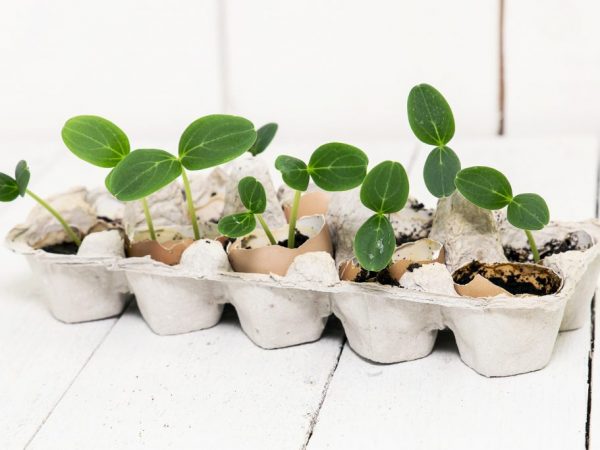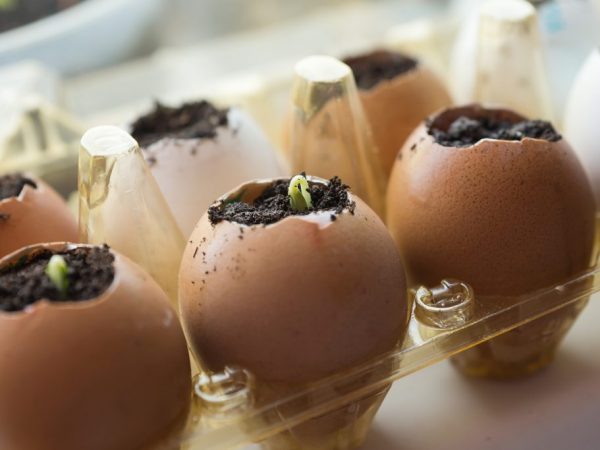Seedlings of cucumbers in eggshell
Cucumbers are a rather capricious culture, with a negative attitude towards transplants. The shells of the eggs will serve as an ideal container for growing these whimsical vegetables, protecting the root system and nourishing the plant with everything it needs to grow. Seedlings of cucumbers in eggshells germinate quickly, do not create problems when transplanted into the ground, are distinguished by good fruit set and rich yields.

Seedlings of cucumbers in eggshell
The benefits of growing in shell
Egg shells for sprouting cucumbers are a natural and environmentally friendly material. The advantages of the growing method include:
- Fertilization of sprouts with calcium carbonate contained in the shell (promotes growth and better fruit set).
- Reducing the level of soil oxidation due to liming, enhancing the effect of mineral dressings.
- Saving space and money for the production of containers for seedlings.
- Environmental friendliness of natural fertilizer, quick decomposition of the shell due to its crystalline structure.
- Protection of the root system when planted in open ground.
- Prevention of damage to the plant by a bear after transplanting to the garden (the pest dies from eating the egg shell).
Landing technology
To grow seedlings of cucumbers in eggshells, you need the following:
- seed (seeds of the selected variety);
- high-quality soil;
- shell;
- container for placement (it is convenient to use cardboard egg pallets);
- cling film.
Harvesting natural pots
It is better to start collecting shells in winter. To plant seedlings, it must be prepared in a special way:
- remove with a sharp knife the upper narrowed part of the egg (about a quarter of the entire surface), pour out the yolk and white;
- with an awl, carefully drill a drainage hole in a wide base;
- rinse the workpieces thoroughly and boil for a couple of minutes to disinfect them;
- dry and store in a cool place until planting (make sure that mold does not form from excess moisture in the air).
Before use, it is better to lower the egg containers for another minute in boiling water and dry them thoroughly. If the workpieces are not disinfected in time, bacteria can grow in them and an unpleasant odor may form. Such containers cannot be used.
Planting seeds

Seedlings need good lighting
Sequence of planting seed in natural pots:
- Fill dry containers 2/3 full with heated soil, consisting of soil with added peat.
- Put non-germinated seeds in each pot (2-3 pcs.) And sprinkle with loosened soil for a couple of cm.
- Moisten liberally with a spray bottle.
- Place containers in cardboard pallets or other supports to prevent breakage.
- Cover them with cling film to avoid drying out the soil and create a greenhouse effect (promotes early germination and rapid growth of the crop).
- Place the pots next to a light source (a lack of natural or artificial light can cause the sprouts to stretch out and reduce future yield).
Sprout care
The volume of soil in a natural pot is small, so the sprouts require daily watering. But over-watering is just as dangerous for cucumbers as drying out. Therefore, it is important to avoid stagnant moisture and regularly check that the drain hole is not blocked.
Seeds sprout about 5-6 days after sowing. After the sprouts appear, the cling film must be removed and the seedlings placed closer to the light source (ideally on the windowsill). If necessary, the seedlings are supplemented with a fluorescent lamp.
It is recommended to start hardening the sprouts 10-12 days before planting, periodically taking them outside for 2-3 hours. This will help the plants grow stronger and prepare for lower temperatures in the open field.
Cucumbers do not need additional dressing until the time of transplantation, because get all the necessary nutrients directly from the shell.
Features of planting in open ground
Planting of seedlings is carried out when the plants are sufficiently strong and favorable weather is established (no day and night frosts). The minimum suitable soil temperature for planting will be 15-17 °. 3 days before planting, it is recommended to leave the seedlings outside for a day for acclimatization.
The process of planting seedlings in eggshells is quite simple and consists of the following steps:
- Planting is done with a minimum of sunlight, early in the morning or late in the evening.
- Before planting, it is necessary to moisten the soil in containers so as not to disturb the layer around the root system.
- Shell pots do not need to be removed. It is enough to squeeze them in the palm of your hand until cracks form, through which the roots can access the rest of the soil.
- The soil for planting requires preliminary preparation: it must be loosened, leveled with a rake and made holes.
- Seedlings together with natural containers must be placed in holes and sprinkled with soil.
After planting, cucumbers need abundant watering, every 3-4 days. A high level of humidity will help the plants take root as quickly as possible.
When transplanting seedlings into open ground, it is important not to thicken the beds and dig holes at a sufficient distance from each other. The distance between plants should be sufficient to obtain the optimal amount of nutrients, moisture and light, even during the entire growing season.
Conclusion
Growing seedlings of cucumbers in eggshells is a convenient alternative to the usual pots and other artificial containers. The use of shells greatly facilitates the planting process and reduces the acidity level of the soil, contributing to the rapid growth of the crop. Cucumbers receive natural supplementary feeding, which quickly decomposes into natural components in the soil. An additional advantage of using the egg shell is the prevention of damage to the culture by the bear.


